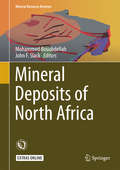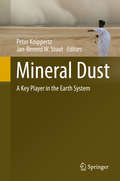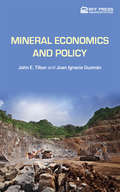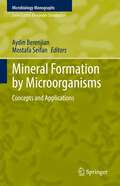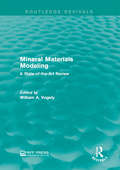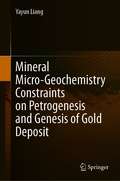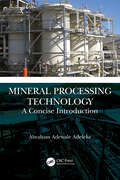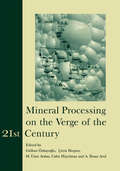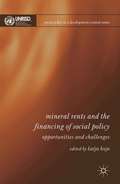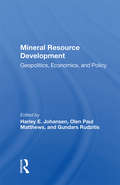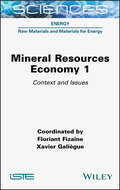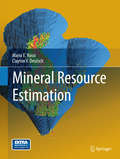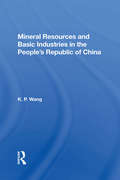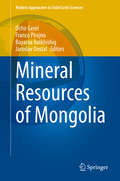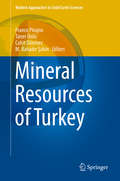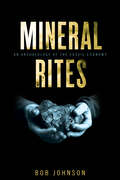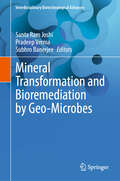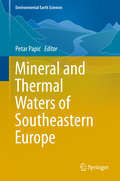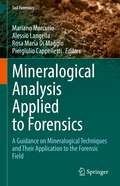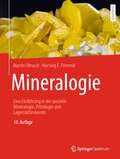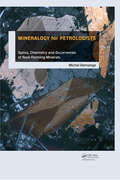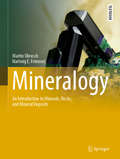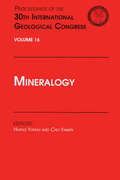- Table View
- List View
Mineral Deposits of North Africa
by Mohammed Bouabdellah John F. F. SlackThis volume presents an exhaustive overview of major orebodiesand mineral deposits of North Africa. It is intended both for academicresearchers and especially for exploration geologists interested in mineralexploration in the northern part of the African continent. Recent changes inthe mining laws of most countries in this region have encouraged internationalmining companies to invest in local mineral industries. Accordingly, thisvolume will be very useful for these professionals, as well as for researchersin the field of economic geology.
Mineral Dust
by Peter Knippertz Jan-Berend W. StuutThis volume presents state-of-the-art research about mineral dust, including results from field campaigns, satellite observations, laboratory studies, computer modelling and theoretical studies. Dust research is a new, dynamic and fast-growing area of science and due to its multiple roles in the Earth system, dust has become a fascinating topic for many scientific disciplines. Aspects of dust research covered in this book reach from timescales of minutes (as with dust devils, cloud processes and radiation) to millennia (as with loess formation and oceanic sediments), making dust both a player and recorder of environmental change. The book is structured in four main parts that explore characteristics of dust, the global dust cycle, impacts of dust on the Earth system, and dust as a climate indicator. The chapters in these parts provide a comprehensive, detailed overview of this highly interdisciplinary subject. The contributions presented here cover dust from source to sink and describe all the processes dust particles undergo while travelling through the atmosphere. Chapters explore how dust is lifted and transported, how it affects radiation, clouds, regional circulations, precipitation and chemical processes in the atmosphere and how it deteriorates air quality. The book explores how dust is removed from the atmosphere by gravitational settling, turbulence or precipitation, how iron contained in dust fertilizes terrestrial and marine ecosystems, and about the role that dust plays in human health. We learn how dust is observed, simulated using computer models and forecast. The book also details the role of dust deposits for climate reconstructions. Scientific observations and results are presented, along with numerous illustrations. This work has an interdisciplinary appeal and will engage scholars in geology, geography, chemistry, meteorology and physics, amongst others with an interest in the Earth system and environmental change. body>
Mineral Economics and Policy
by John E. Tilton Juan Ignacio GuzmánThis textbook provides an introduction to the field of mineral economics and its use in understanding the behaviour of mineral commodity markets and in assessing both public and corporate policies in this important economic sector. The focus is on metal and non-metallic commodities rather than oil, coal, and other energy commodities. The work draws on John Tilton's teaching experience over the last 30 years at the Colorado School of Mines and the Catholic University of Chile, as well as short courses for RioTinto and other mining companies. This is combined with the professional consulting and academic research of Juan Ignacio Guzmán over the past decade, in order to demonstrate the industry application of the economic principles described in the earlier chapters. The book should be an ideal text for graduate and undergraduate students in the fields of mining engineering and natural resource economics and policy. It should also be of interest to professionals and investors in mining and commodity markets, and those undertaking continuing education in the mineral sector.
Mineral Formation by Microorganisms: Concepts and Applications (Microbiology Monographs #36)
by Aydin Berenjian Mostafa SeifanThis book explains how microorganisms play a pivotal role in the formation of biominerals, including carbonates, silicate minerals and oxides. As readers will learn, these minerals may be produced either intracellularly or extracellularly in order to sustain microbial life. Experienced scientists from the field show that some of these biominerals can be produced in an active form, which involves direct enzymatic intervention to form precipitates. In addition, passive mineral formation can be mediated by the presence of dead cells. Readers from Microbiology and Biochemistry will appreciate the thorough coverage on various types of microbial mineral formation and their roles in microbial domains. Furthermore, they will benefit from the authors’ first-hand knowledge regarding common techniques for studying biomineral-producing microorganisms, factors affecting biomineralization, and the use of this process in biotechnological applications.
Mineral Materials Modeling: A State-of-the-Art Review (Routledge Revivals)
by William A. VogelyOriginally published in 1976, this study was undertaken to fill a gap in knowledge about non-fuel resources and the advantages and disadvantages of specific methodologies of analysing material modelling. Mineral Materials Modeling examines the influence of factors such as raw material price and availability, technological aspects and related environmental questions in relation to both economic and mathematical models. The results are particularly helpful in terms of forecasting, policy development and decision-making about mineral materials as well as assessing the usefulness of different types of model. This title will be of interest to students of Environmental Studies as well as policy makers and professionals.
Mineral Micro-Geochemistry Constraints on Petrogenesis and Genesis of Gold Deposit
by Yayun LiangMinerals respond texturally and compositionally to changing magmatic environments and preserve a wealth of information regarding magmatic processes and compositions in their crystal-growth stratigraphy. This book reports the detailed petrography and in-situ geochemistry of the clinopyroxene phenocrysts of the mafic dykes in the Jiaodong Peninsula, southeastern North China Craton, including in-situ determinations of major elements, trace elements, Sr isotopic compositions, and H2O contents with further constraints on the petrogenesis and geodynamics of the mafic dykes. Systematic analyses of mineralogical, major, and trace elements, Sr–Nd isotopes, and in-situ S isotopes on the pyrite of the main gold-bearing mineral assemblages and visible gold were conducted, aiming to explore the source of ore-forming materials and the process of Au element migration and deposition. The geodynamic setting of mineralization in the studied region is also summarized.
Mineral Processing Technology: A Concise Introduction
by Abraham Adewale AdelekeMineral processing technology is a branch of applied science that deals with the principles and practice of separating useful minerals from primary solid ore mineral resources. This book introduces the science and technology of processing solid minerals to concentrates of grades suitable for industrial extraction of metal values and other non-metallic products. It also includes case studies, typical process flowsheets, aspects of the processing of tailings arising from mineral processing plants and worked examples. Features: Includes science and technology of processing solid minerals to concentrates of grades, suitable for industrial extraction of metal values and other non-metallic products. Provides a logical progression from basic to advanced concepts in mineral processing. Designed to stimulate students to think as mineral processing engineers in training. Explores sustainable mineral processing and circular economy in mineral processing. Contains worked examples that clearly illustrate the various theories presented and help readers develop problem-solving skills in mineral processing. This book is aimed at professionals and senior undergraduate students in metallurgy, mining, mineral processing, chemistry and chemical engineering.
Mineral Processing on the Verge of the 21st Century: Proceedings of the 8th International Mineral Processing Symposium, Antalya, Turkey, 16-18 October 2000
by Gülhan Özbayoğlu Çetin Hoşten M. Ümit Atalay Cahit Hiçyılmaz A. İhsan ArolThis collection of papers covers many topics in the area of mineral processing, such as: physical enrichment processing; fine particle processing; flotation fundamentals and technology; industrial minerals processing; and waste treatment and utilization.
Mineral Rents and the Financing of Social Policy
by Katja HujoAn exploration of the implications of mineral-led wealth and the opportunities that this creates for economic and social development. The book includes theoretical and policy analyses as well as micro level country case studies, including Norway, Chile, Indonesia, Nigeria and Botswana.
Mineral Resource Development: Geopolitics, Economics, And Policy
by Harley E JohansenOne of the most significant resource-development and industrial-policy issues facing the United States today is the continued decline of domestic production and processing of metallic minerals and the associated dependence on foreign supplies for our needs. Domestic mining and processing industries have suffered from various economic problems and i
Mineral Resource Economics 1
by Florian Fizaine Xavier GaliegueThe constant increase in the consumption of mineral resources, as well as the growing awareness of their exploitation, is causing deep concern within the scientific community. This concern is justified by the fact that the energy transition will increase the pressure on these resources, as renewable energies require an increased and more diversified quantity of mineral materials.This book presents an overview of the exploitation of these mineral resources, where the natural, regulatory and environmental constraints interfere with economic, financial and geopolitical interests. By mobilizing the fields of the humanities, geosciences and engineering, it also analyzes the challenges that the energy transition will encounter, challenges related to the contradictory effects that the acceleration of the extraction of these resources will have on their physical availability, the economies that exploit them and the populations that live off of them
Mineral Resource Estimation
by Clayton V. Deutsch Mario E. RossiMineral resource estimation has changed considerably in the past 25 years: geostatistical techniques have become commonplace and continue to evolve; computational horsepower has revolutionized all facets of numerical modeling; mining and processing operations are often larger; and uncertainty quantification is becoming standard practice. Recent books focus on historical methods or details of geostatistical theory. So there is a growing need to collect and synthesize the practice of modern mineral resource estimation into a book for undergraduate students, beginning graduate students, and young geologists and engineers. It is especially fruitful that this book is written by authors with years of relevant experience performing mineral resource estimation and with years of relevant teaching experience. This comprehensive textbook and reference fills this need.
Mineral Resources and Basic Industries in the People's Republic of China
by K.P. WangFirst published in 1977. Mining and metallurgy have had a long history in China, and resources there have always been considered promising. More recently, in the People's Republic of China (PRC), a remarkable industrial renaissance is underway that should gain further momentum in the years ahead. Rapid development of minerals has brought the PRC prominence not only in the area of industrialization, but also in world affairs. Chinese mineral developments, especially in petroleum, have been increasingly in the news. A very large coal industry is already in existence. The steel industry ranks fifth or sixth in the world. The PRC is also prominent in fertilizer, cement, and salt production, and its export metals are well known. The need to know about Chinese mineral developments and the intense interest in them have prompted Dr. Wang's study. Emphasizing the world significance of Chinese minerals, he reviews the history of growth in the PRC' s mineral industry and its present supply position; evaluates policy considerations and regional technical factors affecting mineral development; and assesses the PRC's mineral trade and its efforts to obtain equipment, supplies, and new technology.
Mineral Resources of Mongolia (Modern Approaches in Solid Earth Sciences #19)
by Franco Pirajno Ochir Gerel Bayaraa Batkhishig Jaroslav DostalThis book provides a brief geology, tectonic structure and metallogeny of Mongolia, central part of the giant Central Asian Orogenic Belt, and broad overview of major metallic (copper, gold, rare metals and rare earths, iron, lead and zinc, silver and platinum group), non-metallic (phosphorite and fluorspar) and fuel (uranium and coal) mineral deposits and occurrences, covering their tectonic position, metallogeny and deposit types, geological characteristics and origin, including newly found deposits and occurrences based on authors research data and a large information obtained during geological exploration work. The book is intended for professional economic geologists, for earth science students and practicing geologists.
Mineral Resources of Turkey (Modern Approaches in Solid Earth Sciences #16)
by Franco Pirajno Taner Ünlü Cahit Dönmez M. Bahadır ŞahinThis book furnishes detailed information about Turkey's existing mineral resources, besides providing concepts and ideas which may help the search for potential mineral resources in the future. It is a first book in the English-language international literature on mineral resources of Turkey and it is aimed at economic geologists, mining engineers, and mining investors, as well as graduate and undergraduate students. This work focuses mainly on a range of mineral systems and related geological features throughout Turkey. Taking into account the lack of international literature on these resources, a considerable portion of the book explains the geological context of the region and the settings in which the mineral resources occur. The genetic characteristics of these mineral resources are emphasized and important information is also presented on their economic aspects. All chapter contributions are prepared by researchers and professional geologists.
Mineral Resources, Economics and the Environment
by Kesler, Stephen E. and Simon, Adam C. Stephen E. Kesler Adam C. SimonWritten for students and professionals, this revised textbook surveys the mineral industry from geological, environmental and economic perspectives. Thoroughly updated, the text includes a new chapter on technology industry metals as well as separate chapters on mineral economics and environmental geochemistry. Carefully designed figures simplify difficult concepts and show the location of important deposits and trade patterns, emphasising the true global nature of mineral resources. Featuring boxes highlighting special interest topics, the text equips students with the skills they need to contribute to the energy and mineral questions currently facing society, including issues regarding oil pipelines, nuclear power plants, water availability and new mining locations. Technical terms are highlighted when first used, and references are included to allow students to delve more deeply into areas of interest. Multiple choice and short answer questions are provided for instructors online at www. cambridge. org/kesler to complete the teaching package.
Mineral Rites: An Archaeology of the Fossil Economy (Energy Humanities)
by Bob JohnsonAn archaeology of Western energy culture that demystifies the role that fossil fuels play in the day-to-day rituals of modern life.Spanning the past two hundred years, this book offers an alternative history of modernity that restores to fossil fuels their central role in the growth of capitalism and modernity itself, including the emotional attachments and real injuries that they generate and command. Everything about us—our bodies, minds, sense of self, nature, reason, and faith—has been conditioned by a global infrastructure of carbon flows that saturates our habits, thoughts, and practices. And it is that deep energy infrastructure that provides material for the imagination and senses and even shapes our expectations about what it means to be fully human in the twenty-first century. In Mineral Rites, Bob Johnson illustrates that fossil fuels are embodied today not only in the morning commute and in home HVAC systems but in the everyday textures, rituals, architecture, and artifacts of modern life. In a series of illuminating essays touching on such disparate topics as hot yoga, electric robots, automobility, the RMS Titanic, reality TV, and the modern novel, Johnson takes the discussion of fossil fuels and their role in climate change far beyond the traditional domains of policy and economics into the deepest layers of the body, ideology, and psyche. An audacious revision to the history of modernity, Mineral Rites shows how fossil fuels operate at the level of infrapolitics and how they permeate life as second nature.
Mineral Transformation and Bioremediation by Geo-Microbes (Interdisciplinary Biotechnological Advances)
by Pradeep Verma Santa Ram Joshi Subhro BanerjeeThis book investigates the pivotal role of microorganisms in elemental cycling and degradation processes, offering a comprehensive exploration of their chemical reactivity and metabolic diversity. By examining the interaction of microorganisms with geological activities, this volume highlights their influence on biotransformation and bioremediation. Readers will find an in-depth review of geo-microbes' applications in soil improvement and environmental restoration, alongside discussions on bio-sediment, bioleaching, and elemental cycling. The chapters offer expert analysis and diverse perspectives in microbiology, geology, and environmental biotechnology. Key concepts include the geomicrobiological interactions in extreme environments, the transformation of toxic elements, and the potential for extraterrestrial life models. Chapters delve into the rehabilitation of saturated lands, the role of geo-microbes in arsenic transformation, and the ecological restoration of wetlands. The book is invaluable for researchers, students, and professionals in microbiology, biotechnology, geology, and environmental sciences. It also serves as a major reference for understanding the microbial processes that shape our planet and offers practical insights for harnessing the power of geo-microbes for sustainable environmental solutions. While comprehensively reviewing geo-microbes in biotransformation processes, the book provides the knowledge and tools necessary to advance the readers’ understanding of geomicrobiology and its applications.
Mineral and Thermal Waters of Southeastern Europe
by Petar PapićThis book brings together the latest findings on mineral and thermal waters from countries in Southeastern (SE) Europe (Croatia, Bosnia and Herzegovina, Serbia, Montenegro, Macedonia, Albania, Romania and Bulgaria). Each chapter is dedicated to the most recent geochemical and hydrogeological investigations for a specific country in SE Europe, helping readers to understand the origins and applications of mineral and thermal waters - aspects which are of great importance for the economic development of this region, as these waters are renewable resources, and have been gaining in popularity over the last few decades. Thanks to the region's favorable geological conditions, it is home to more than 6,000 sources of mineral and thermal waters, characterized by different physical properties and chemical compositions.
Mineralogical Analysis Applied to Forensics: A Guidance on Mineralogical Techniques and Their Application to the Forensic Field (Soil Forensics)
by Rosa Maria Di Maggio Mariano Mercurio Alessio Langella Piergiulio CappellettiThis book illustrates the main modern mineralogical analytical procedures that can be applied for forensic purposes on various typologies of materials and substances and has both theoretical and practical approach. Moreover, it focuses on all those challenges that can arise with forensic analysis, such as the choice of the most proper mineralogical techniques as a function of the material and its quantity, destructive and non-destructive analyses, sampling procedures, mineralogical analysis of micro-traces, correct preparation of the samples, correct calibration and analytical conditions of the laboratory instrumentation. Numerous case studies on criminal offenses against persons, environment and cultural heritage are illustrated.
Mineralogie: Eine Einführung in die spezielle Mineralogie, Petrologie und Lagerstättenkunde
by Martin Okrusch Hartwig E. FrimmelDieses Buch bietet eine vergleichsweise umfangreiche Einführung in die spezielle Mineralogie, Petrologie, Geochemie und Lagerstättenkunde. Es entwickelte sich aus dem ursprünglich von Siegfried Matthes konzipierten, dann von Martin Okrusch weitergeführten Lehrbuch, das mittlerweile zu einem bewährten Klassiker geworden ist. Die vorliegende, mittlerweile 10. Neuauflage unterscheidet sich von den Vorgängern durch eine komplette Überarbeitung von Text und Abbildungen, die stark von der Handschrift Hartwig Frimmels, dem Nachfolger von Martin Okrusch, geprägt ist. Dabei aber blieben die Autoren der Grundidee eines für den geowissenschaftlichen Unterricht an der Universität zugeschnittenen Lehrbuchs treu, welches die langjährige Erfahrung der Autoren in Lehre und Forschung widerspiegelt. Zahlreiche Hinweise auf die wirtschaftliche Bedeutung von Mineralen, Gesteinen und Erzen werden dem wieder erstarkten gesellschaftlichen Interesse an der zukünftigen Versorgung mit mineralischen Rohstoffen gerecht. Die gegenüber anderen, insbesondere Internetquellen deutlich tiefer gehende Bearbeitung von Themen ermöglicht es, ein Verständnis für die komplexen Zusammenhänge zwischen Geomaterialien und geologischen Prozessen – sei es auf der Erde oder auf anderen Himmelskörpern – aus moderner Sicht zu entwickeln. Dabei wird aber nicht auf essentielle Grundlagen verzichtet, auch wenn sie schon vor Jahrzehnten entwickelt worden sind. Nicht zuletzt wegen seiner umfangreichen Bebilderung ist das Buch wertvolles Handwerkszeug für interessierte Mineraliensammler.
Mineralogy for Petrologists: Optics, Chemistry and Occurrences of Rock-Forming Minerals
by Michel Andre DemangeThis book provides a categorized and visualized overview and presents microscopic observations, systematic mineralogy, chemistry, geology, stability, paragenesis, occurrence and use in petrology of 137 minerals. Structural formula calculations are included in the appendix. Consists of a set of book and downloadable resources for students and practically-oriented researchers and professionals in geology, geological, mining, and mineral resources engineering who need a reference of mineralogy, applied to petrology.The downloadable resources contain 384 color plates with mineral microscopic visuals under various circumstances.
Mineralogy: An Introduction to Minerals, Rocks, and Mineral Deposits (Springer Textbooks in Earth Sciences, Geography and Environment)
by Martin Okrusch Hartwig E. FrimmelThis book presents a translation and update of the classic German textbook of Mineralogy and Petrology that has been published for decades. It provides an introduction to mineralogy, petrology, and geochemistry, discussing the principles of mineralogy, including crystallography, chemical bonding, and physical properties, and the genesis of minerals in a didactic and understandable way. Illustrated with numerous figures and tables, it also features several sections dedicated to the genesis of mineral resources. The textbook reflects the authors’ many years of experience and is ideal for use in lectures on mineralogy and petrology.
Mineralogy: Proceedings of the 30th International Geological Congress, Volume 16
by Huang Yunhui Cao YawenThis book is a collection of papers presented in the 30th International Geological Congress, held in Beijing, on mineralogy. The papers deal with topics on fine structures and crystallographic orientations in biogenic magnetite and thermodynamic properties of minerals.
Minerals
by Hans-Rudolf Wenk Andrei BulakhThis introduction to mineralogy for undergraduate and graduate students in geology and materials science has been designed for a semester course. Covering all aspects of mineralogy in an integrated way, it links mineral properties with broader geological processes, and conveys their economic importance throughout the text. Handy reference tables and a glossary of terms make this study an indispensable guide for the next generation of mineralogy students.
